I don’t think I’ve ever spent as much time crafting an itinerary as I did for Albania.
Take the following three ingredients:
- A limited amount of time in which to see the country
- A desire to see as much of it as possible
- A reluctance to hire a car
Blend them all together, and hey presto: you’ve got yourself a recipe for frustration. I’m not exaggerating when I say it took two weeks of work to create a route that made sense.
This was partially due to the unhingedness that is taking public transport in Albania. Many destinations in this country aren’t connected by direct bus, connections are difficult to manage due to the elusiveness of signposted stations, and travel days can be arduous, featuring long journeys and the need to backtrack to reach a destination. (At the same time, renting a car sounded like even more of a nightmare).
Nevertheless, I persisted, and managed to come up with what I believe is the perfect 10-day itinerary for Albania.
I managed to combine the hipster streets of Tirana with the ancient alleyways of Berat and Gjirokastër, the buzzy, white-sand beaches of Ksamil with the impressive ruins of Butrint, then squeezed in the laidback coastal vibes of Himare to recover from it all.
With 10 days in the country, you’ll need to choose two of the following three options: hiking in the north, beach-hopping along the coast, and exploring historic inland towns. We chose the last two, because we wanted to see Albania’s beaches and couldn’t imagine heading to the country and not seeing UNESCO-listed Berat and Gjirokaster. I’m so happy we did, because we loved everywhere we visited!
As mentioned, we didn’t rent a car and decided to use public transport instead. I’ll give detailed instructions on how to best navigate the country’s bus system so you can do the same as us, but you can absolutely copy this itinerary if you’re driving, too.
Here’s how we spent our time in the country.
Day One: Getting to Know Tirana
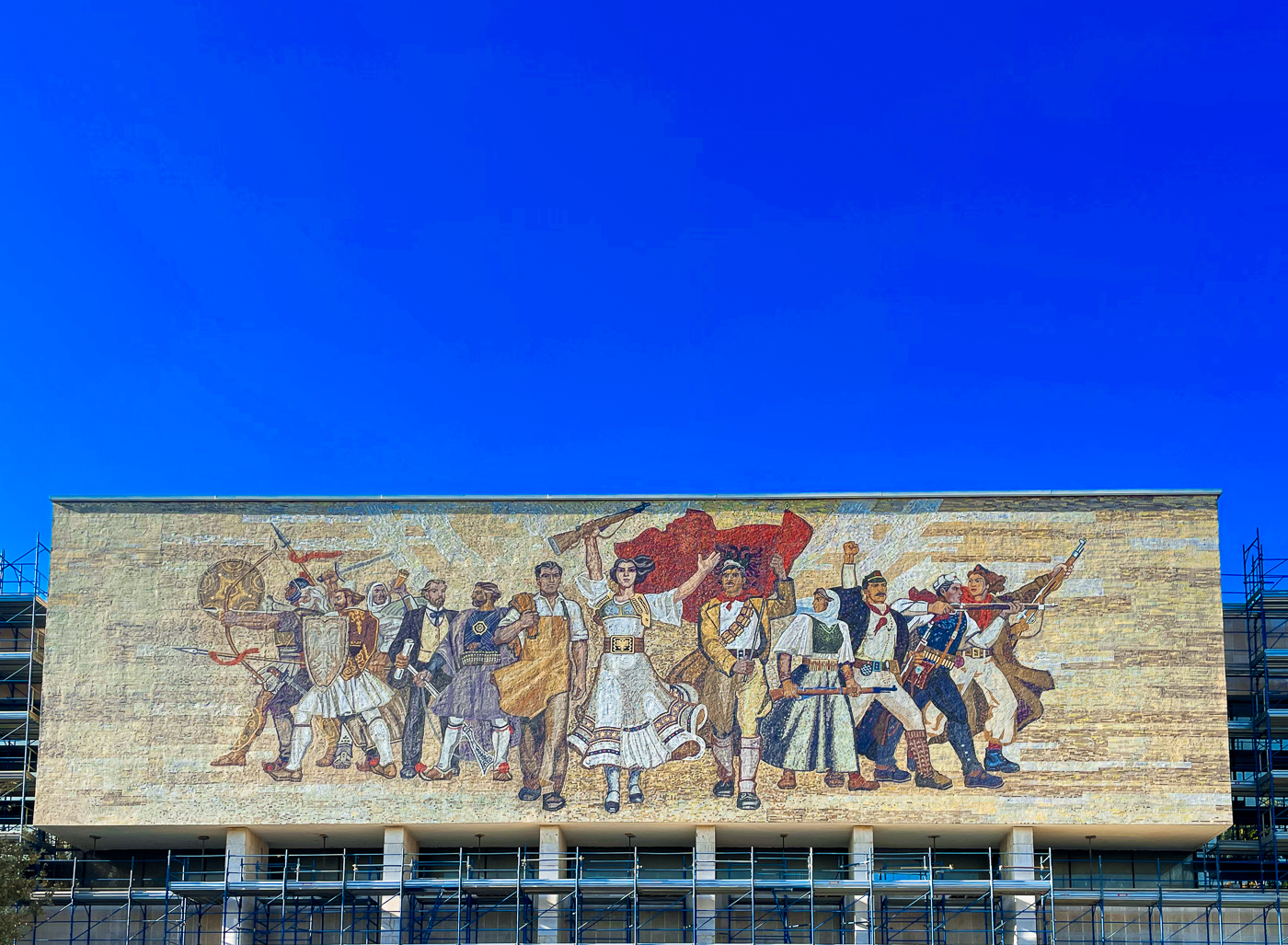
Welcome to Tirana! This hipster city is a fascinating one, filled with high-end restaurants, grungy architecture, luscious parks, and important museums. On day one, we’re going to get a sample of all of these, sweating our way through underground bunkers, marvelling at quirky structures, and eating our body weight in byrek.
The most important move to make on your first day is to get yourself to Bunk’Art 2 by 9:30 a.m., which is when this bunker-turned-museum opens. Trust me: you do not want to be crammed underground in a concrete bunker with 200 strangers and no air conditioning, attempting to focus on harrowing stories of death and torture. Get yourself there as soon as it opens and you’ll be able to breathe easier.
So why visit? Bunk’Art 2 was once a nuclear shelter built for Albania’s secret police during paranoid dictator Enver Hoxha’s communist rule. Today, it’s a museum and doesn’t hold back in showing just how brutal this regime was. You’ll learn about the unfathomable levels of surveillance across the country, the forced labour camps, and the torture methods inflicted on anyone deemed disloyal. Honestly, it’s dark and unsettling, and both Dave and I emerged into the bright sunlight two hours later feeling more than a little disturbed.
Still, visiting Bunk’Art 2 is essential for every visitor to Albania: it gives you a real understanding of the country’s history and the struggles that shaped it. I couldn’t imagine travelling around the country without that knowledge.
Once you’ve resurfaced, take a stroll over to the neighbouring Skanderbeg Square. This is the main plaza in Tirana, surrounded by imposing government buildings, museums, and a mosque, with a huge statue of Skanderbeg himself as the focal point. The square’s always buzzing and fun to wander through. Don’t miss Et’hem Bej Mosque for a glimpse at its intricate ceilings, then head to the Clock Tower to take photos of the square from above.
Grabbing a byrek for lunch in Tirana is a no-brainer: it’s cheap, delicious, and absolutely everywhere. These flaky, golden pastries come stuffed with fillings like cheese, spinach, and meat, and deciding which one to get is the hardest part. The best ones we tried were from Byrek Special “Luani”, which is a four-minute walk from the square.
Next stop: the Old Bazaar! This is the main market of Tirana, with stalls piled high with fresh vegetables, local honey, olives and figs, plus some extremely sketchy-looking raki (local liquor) sold in plastic water bottles at a price of $3 for 250 ml. From there, head over to Tirana Castle, which is an excellent place to pick up some souvenirs and gifts; I bought a magnet and wooden bowl from Subashi Olive Oil Shop.
When you’ve finished browsing the shops, you’ll be steps away from the Mosque of Namazgah: Tirana’s newest (completed in 2024) and biggest mosque. It’s huge — the largest mosque in the Balkans — holding up to 10,000 worshipers at once. I felt like I was in Istanbul when I saw it! It’s free to go inside and worth doing so: its interior is so beautiful.
From the mosque, it’s just a short walk over to Saint Paul’s Cathedral, one of the most unusual churches I’ve ever stepped foot in. It’s super-modern, with white walls, bright lights, and a minimalist design. There’s a huge mosaic of Mother Teresa inside and stained glass windows depicting Pope John Paul II. It’s so different to the ornate cathedrals you normally find in Europe.
When sunset rolls around, there’s one place to be: Tirana’s Pyramid!
Now, this pyramid has been totally transformed from its quirky, decaying self of a few years ago. Once a weird, unfinished relic of the communist era, the overgrown structure has since been cleaned up and renovated, and is now filled with art spaces, workshops, and cafes. It still retains its strange vibe, fortunately, and is great to climb up to get a view of the city. I loved visiting at sunset.
In Albania for a special occasion? I highly recommend having dinner at SALT, which turned out to be mine and Dave’s favourite restaurant in the city. We visited for Dave’s birthday, in fact, and the staff took such good care of us! This’ll also give you an insight into modern Albania, with its thriving, hipster food scene; the sushi we ate here was as good as any we had in Japan, and the steak was grilled to perfection! Their fantastic cocktails rounded off the evening perfectly.
Where we stayed: UrbanBllok5 (€50 a night) — Dave and I absolutely adored our colourful room at UrbanBllok5! It’s located in the coolest neighbourhood in Tirana — Blloku — surrounded by all the best bars and restaurants. Despite that, the room was silent, even on busy weekend nights. The internet was super-fast, the shower pressure was great, and the air conditioning worked well. We met the owner outside the property after flying into Tirana, which made checking in easy. There was even free fruit placed out every morning for all the guests!
Day Two: Hipsters, Hikes, and a Haunting History Lesson
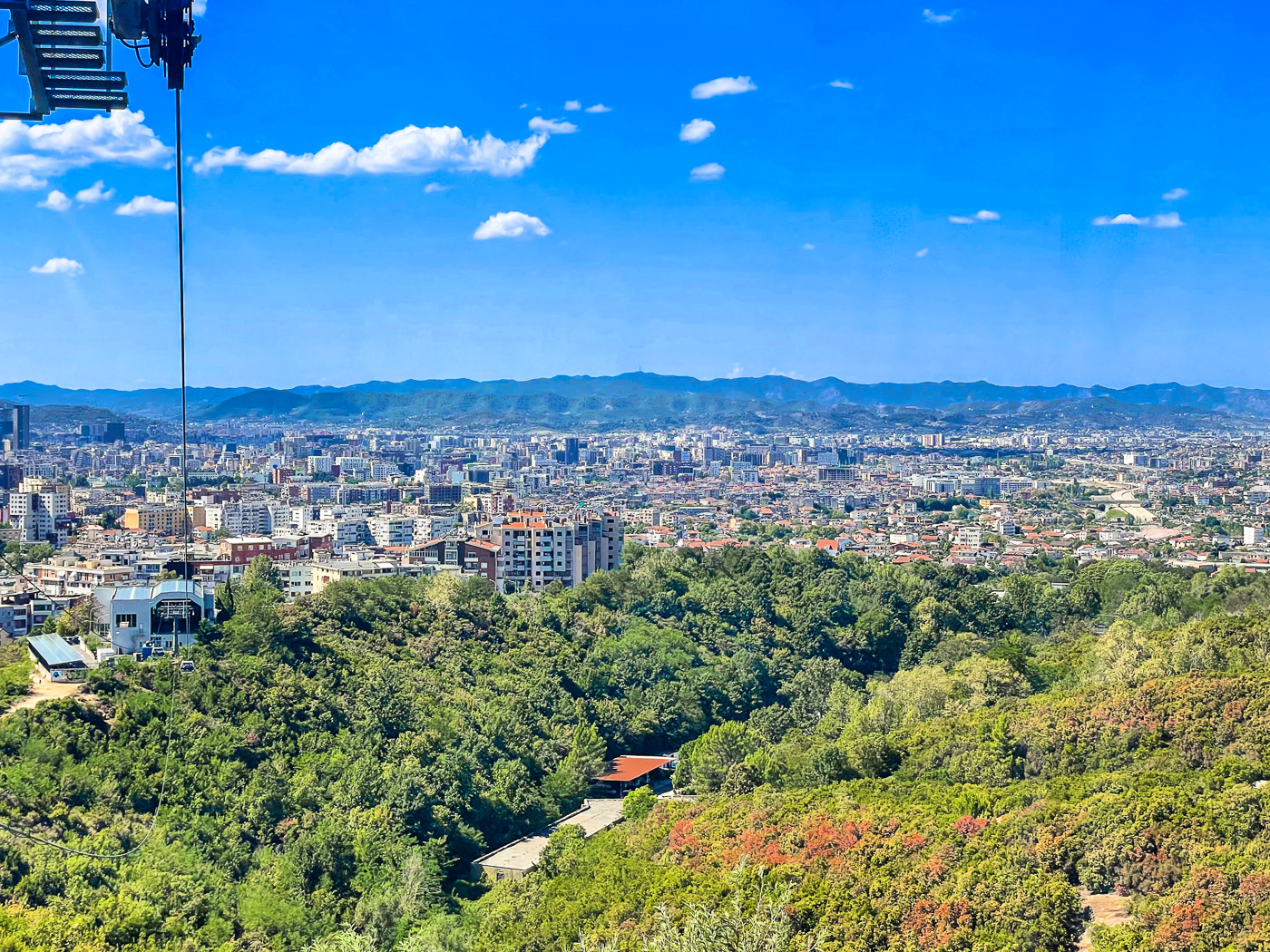
On day two, we’re going to fill our boots with even more Tiranan contrasts, from a cable car ride up to one of the highest points in the city to the subterranean depths of yet another Cold War-era bunker.
Kick off the day with breakfast in Blloku: the hipster neighbourhood of Tirana. Our favourite spot was Mulliri Gourmet, where the coffee was strong, the pastries flaky, and the atmosphere buzzy and fun. I enjoyed the avocado toast while Dave was a huge fan of Grandma’s Fried Dough: a savoury doughnut served with feta cheese and drizzled with honey.
We’ll start our explorations today by taking a Patoko over to the Dajti Express Cable Car.
Patoko is Albania’s version of Uber; it’s not the greatest app, but there’s plenty of drivers, so it can always get you where you need to go. The cable car ride is a long one; so long, in fact, it had Dave and I convinced it was the longest one in the world (it’s not even close). Still, it’s a beautiful ride heading up into the mountains, especially if you land yourself with a blue-sky day, like we did.
Up at the top, you’ll find numerous lookouts, an overpriced cafe, and several poorly signposted hiking trails that’ll lead you to alternate viewpoints outside of the city. We got lost attempting to follow the signs to the spot marked “View to the North from Dajti”, but maybe you’ll have better luck than we did. I think this would be a great spot to have a picnic, too, so if you were motivated, you could grab some supplies from Tirana before setting out.
Once you’re back down at ground level, you’ll find yourself a couple of minutes away from Bunk’Art 1: the sister museum to Bunk’Art 2. Given its location — quite a way outside of Tirana — it’s way less crowded than the one you saw yesterday, and given that it’s also right there, there’s no reason not to visit. I actually found it better than Bunk’Art 2, so if you were going to visit just one, I’d choose this one.
Bunk’Art 1 focuses less on the country’s secret police and more on the history of Albania from around WWII until the 1990s, particularly the oppressive dictatorship of Enver Hoxha. It’s just as dark and unsettling as Bunk’Art 2, and you can’t help but feel the weight of the isolation and paranoia that gripped this country for decades.
Albania’s tragic history is relatively unknown on a global stage — I knew little more than “paranoid dictator built bunkers everywhere” before arriving — so I found this part of the trip fascinating. I came away with monologues full of facts for family and friends, so motivated to inform them about this little country with a shockingly brutal past.
Once you’ve finished off in Bunk’Art 1, grab a Patoko back to Skanderbeg Square and make your way over to the Resurrection of Christ Orthodox Cathedral. In terms of unusualness, this church manages to give yesterday’s cathedral a run for its money. It’s both imposing and glamorous at the same time, huge and hulking from the outside, with sizeable golden decorations and turquoise murals on the inside.
For our last activity in Tirana, I’m going to recommend crossing the road and hitting up the House of Leaves Museum, which was my favourite in the city.
If you’re anything like me, you’re going to be feeling pretty burned out on Albanian dictatorships at this stage — I considered skipping out on it — but this was super-interesting, as it focuses on how ordinary Albanians were spied on by their own government.
The building was once the headquarters of the country’s secret police, and the exhibitions are all about the sheer scale of surveillance of citizens: hidden microphones in homes, dossiers on neighbours, wiretaps everywhere. It’s creepy, chilling, and fascinating in equal measure, and I couldn’t imagine having to live in a country where you have to watch what you say to everybody, even inside your own home. In many cases, it was your fellow citizens and neighbours who were spying on you, and I don’t know how you’d ever learn to trust anybody again.
For dinner, I recommend heading to Blloku’s Era Restaurant to try some of Albania’s more traditional dishes. We tried the Djath Furre (baked sheep’s cheese with vegetables), the oven-baked meatballs in a tomato and plum sauce, and the Kosovo sausages with lima beans. It was all so tasty and we loved seeing a menu with some lesser-known Albanian dishes from the past, too!
Day Three: Onwards to Berat
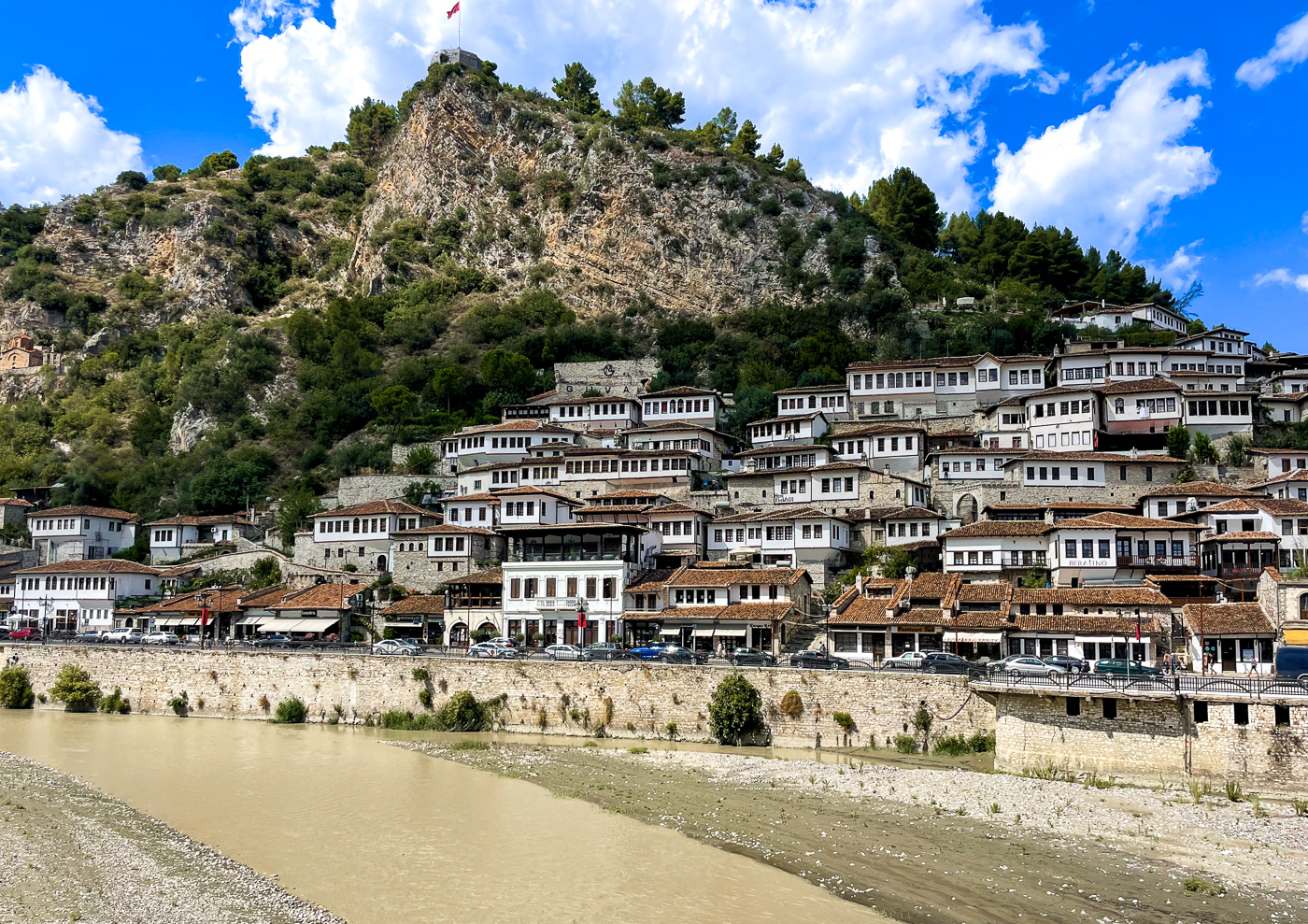
Berat is one of the coolest spots in Albania, so I couldn’t imagine visiting the country and not seeing it. Getting there is relatively simple: take a Patoko from your accommodation to the South and North Bus Terminal in Tirana and buy a ticket for the 8:30 a.m. departure. You’ll arrive at Berat at 10:45 a.m. Give yourself plenty of time to get to the station, however, because Patoko isn’t always reliable.
Annoyingly, the majority of bus stations in Albania are located outside cities rather than in their centres, so you’ll be dropped off on the outskirts of Berat. From there, you can catch a bus to your accommodation, but I recommend just taking a taxi instead (there’ll be plenty waiting there): it’s a short distance and costs 250 Lek (€2.50).
But where to take the taxi to? When it comes to accommodation in Berat, you have two options: staying within the walls of Berat Castle or staying in the Gorica Quarter (the part with all the windows). For us, it was a no brainer. How many times do you get to sleep inside a fortress? It also means you can explore the grounds of the castle at night, when all of the day trippers and tour groups have disappeared; we loved it. We stayed at the wonderful Kris Guesthouse in Berat and can’t say enough great things about it.
If you’ll be staying within the fortress, like we did, head first to Klea Restaurant and make a reservation for dinner. It’s the best restaurant in the castle but is very popular and often has an hour-long wait if you haven’t reserved a table. Then, it’s time to get exploring.
Within the castle walls, make your way to the nearby St. Mary of Blachernae Church (amazing artwork inside), the head of Constantine the Great (a gigantic bust of Emperor Constantine), the Holy Trinity Church (extremely picturesque exterior), and the ruins of the Red Mosque (only the minaret remains, but you can scale it to get great views of the countryside).
From there, I recommend winding your way roughly in the direction of the spot marked “Berat Viewing Platform” on Google Maps, and descending down to St Michael’s Church. The views are amazing from the viewing platform, looking down over Berat’s Gorica Quarter, from an angle that you don’t often see online. Odds are, when you get to the church, there’ll be a strange man sitting inside who’ll ask you for money. We gave that a pass, but admired it from the outside.
Once down beside the river, you can start to soak up those iconic views of Berat with the houses all seemingly staring down at you in unison. Walk towards Gorica Bridge and you’ll be rewarded with one of the best spots to take photos.
My favourite lunch stop is just over the bridge: Eni Traditional Food Berat. Our food here was delicious and inexpensive, and it’s where I fell in love with fërgesë, a sort-of stew made from peppers, cheese, and tomatoes, then baked in an oven until it’s rich and gooey. Dave loved the kima and eggs: minced meat baked with tomatoes, onions, eggs, and topped with fresh herbs.
Next up: getting to know the Gorica Quarter, where Berat is at its most picturesque. This historic neighbourhood, with its Ottoman-era houses stacked up on the hillside, is so unique, and wandering its narrow, cobblestoned alleyways was such a treat. There’s not a huge amount to do here — aside from taking photos of the Church of St. Spiridon — but it’s still a lovely spot for meandering through and soaking up the vibes.
At the other end of the Quarter, you’ll come to another bridge, Ura e Varur. After crossing it, start the climb back up to the fortress. Have a quick look beforehand to see if the Ethnographic Museum happens to be open. This traditional home is packed with old Berat artefacts and sits halfway up the hill, so it’s the perfect spot to catch your breath… if it happens to be open, that is. It’s been closed for renovations for a couple of years now.
One attraction that is open, however, is the impressive Muzeu Kombëtar Ikonografik Onufri. Now, as somebody who is decidedly unreligious, the fact that I’m recommending a gallery full of religious art really says something about how cool this place was. I was blown away by the beautiful artwork in this museum. Seriously — I highly recommend paying the small entrance fee to check it out!
For dinner, head to Klea Restaurant, if you made a reservation, and dine in their beautiful garden, catching glimpses of the fortress walls and surrounding mountains. This family-run restaurant serves up traditional Albanian dishes; I recommend the stuffed eggplant and moussaka.
Before you head back to your guesthouse to sleep, spend an hour walking through the fortress and stopping off at some of the viewing platforms as you go. I loved the quiet vibes at this time of night, when Dave and I only saw a handful of other people wandering around. Plus, the views down towards the town at night were so special: all of the windows were lit up and looked so cosy!
Where we stayed: Kris Guesthouse (€50 a night) — Kris Guesthouse was the best-rated property in town and was just as cosy as we imagined. Our room was spacious and decorated in a traditional style, the owner was super-helpful, and we were within walking distance of everything. The rooftop terrace offered up amazing views over the town, too; the perfect spot for enjoying the homemade breakfast each morning.
Day Four: More Berat and Off to Gjirokaster!
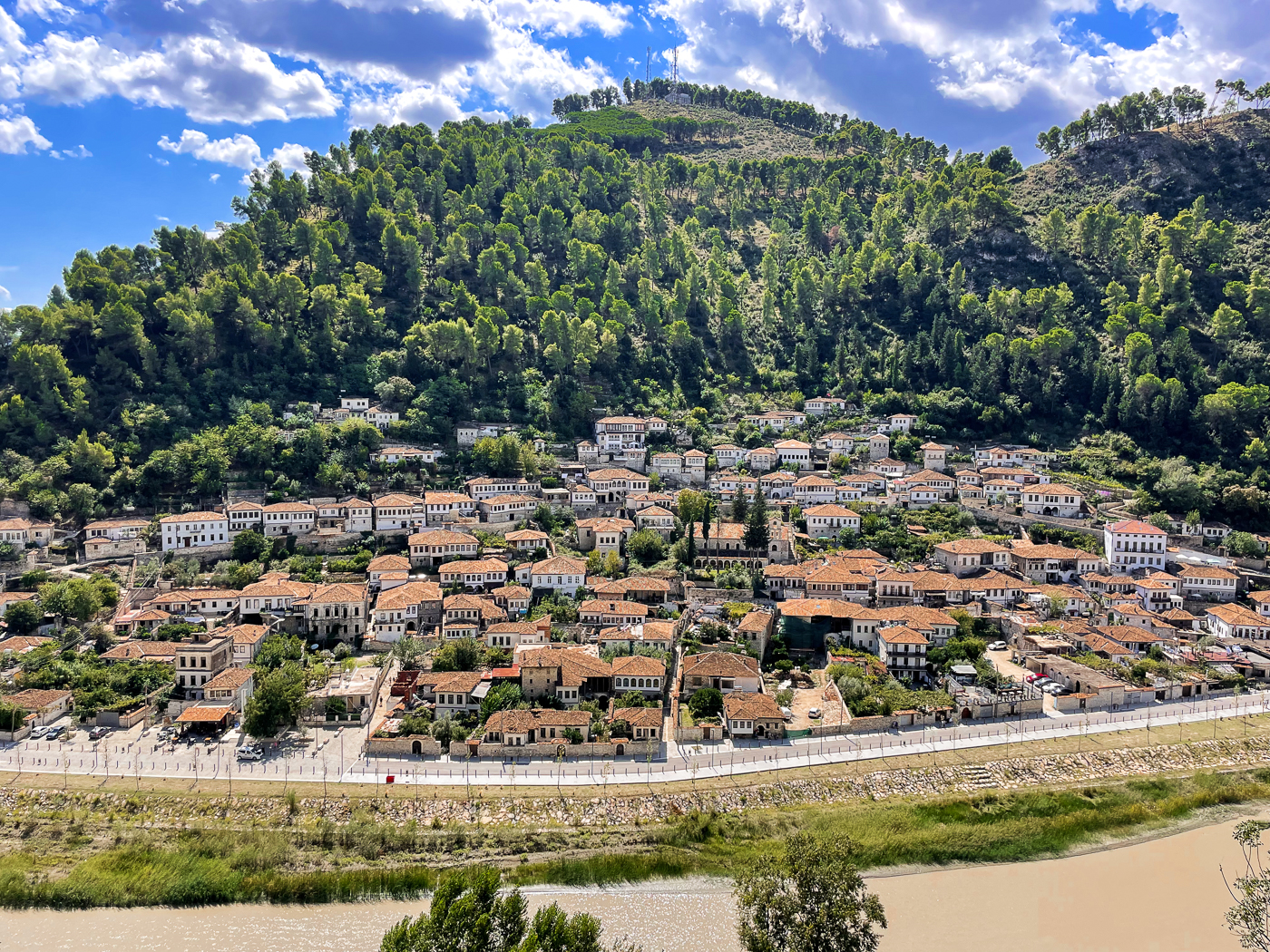
The biggest headache from my Albania trip was trying to figure out how to get from Berat to Gjirokaster. You’d think it’d be simple, given that both towns are popular and on most tourists’ itineraries, but alas!
There are two direct buses a day running from Berat to Gjirokaster — at 8 a.m. and at 2 p.m. — and I would strenuously recommend choosing one of them. (We attempted to travel to Gjirokaster via Fier, and it was one of the worst travel days I’ve had — the bus station in Fier is a random spot on the side of a motorway with no signage, so impossible to find unless you ask a local who knows).
I’d recommend the 2 p.m. direct bus so that you don’t have to wake up too early — as you’d want to leave Berat half an hour before the departure time — with the added bonus of having a morning to explore more of Berat.
After you’ve filled up on the sizeable breakfast at Kris Guesthouse, descend the hill and spend a couple of hours exploring the Mangalem Quarter. This part of Berat was traditionally home to Albanian Muslims, so it’s a great place to go mosque-hopping.
There are three main mosques to check out: the 16th-century Sultan’s Mosque is the oldest in Albania, the Lead Mosque gets its name from the coating on its impressive dome, and the Bachelors’ Mosque was randomly built by unmarried craftsmen for unmarried craftsmen. All three are worth visiting, but if you’re not keen to see them all, I’d say go with Bachelors’ Mosque as the historic paintings inside were so different to any other mosque I’ve visited!
Next, head over to Boulevard Republika, a pedestrianised street with amazing views looking up towards the castle. There’s a ton of restaurants and cafes around this area, too, so it makes for a great place to stop for lunch.
Once the afternoon rolls around, it’ll be time to head back to the guesthouse to collect your bags and set off for Berat’s bus station.
Once you arrive in Gjirokaster, you’ll get dropped off outside the town, so as with Berat, I recommend taking a taxi up to the old town entrance — this comes in at 250 Lek, too.
By the time you reach your guesthouse and check in, it’ll be time for dinner. Gjirokaster is well-known for its food scene, so there are plenty of places to choose from. Our guesthouse owner recommended the traditional restaurant Rumors, which was just around the corner. Too easy! We had another great meal here, opting to share the traditional mix dish, which ended up being an enormous plate of a dozen different Albanian specialties. The green cabbage pie was my favourite: so much better than it sounds!
Where we stayed: Alsara Guesthouse (€50 a night) — If I had to choose just one property as my favourite in Albania, I would have to go with Alsara. The owner was absolutely wonderful! He met us in town to walk us to his guesthouse, served us an amazing breakfast in the morning, and shared all of his favourite restaurants that aren’t frequented by tourists. He even drove us to the bus station at the end of our stay! The guesthouse is right in the heart of the old town, but the rooms are silent, so we were able to sleep well.
Day Five: Diving into Gjirokaster
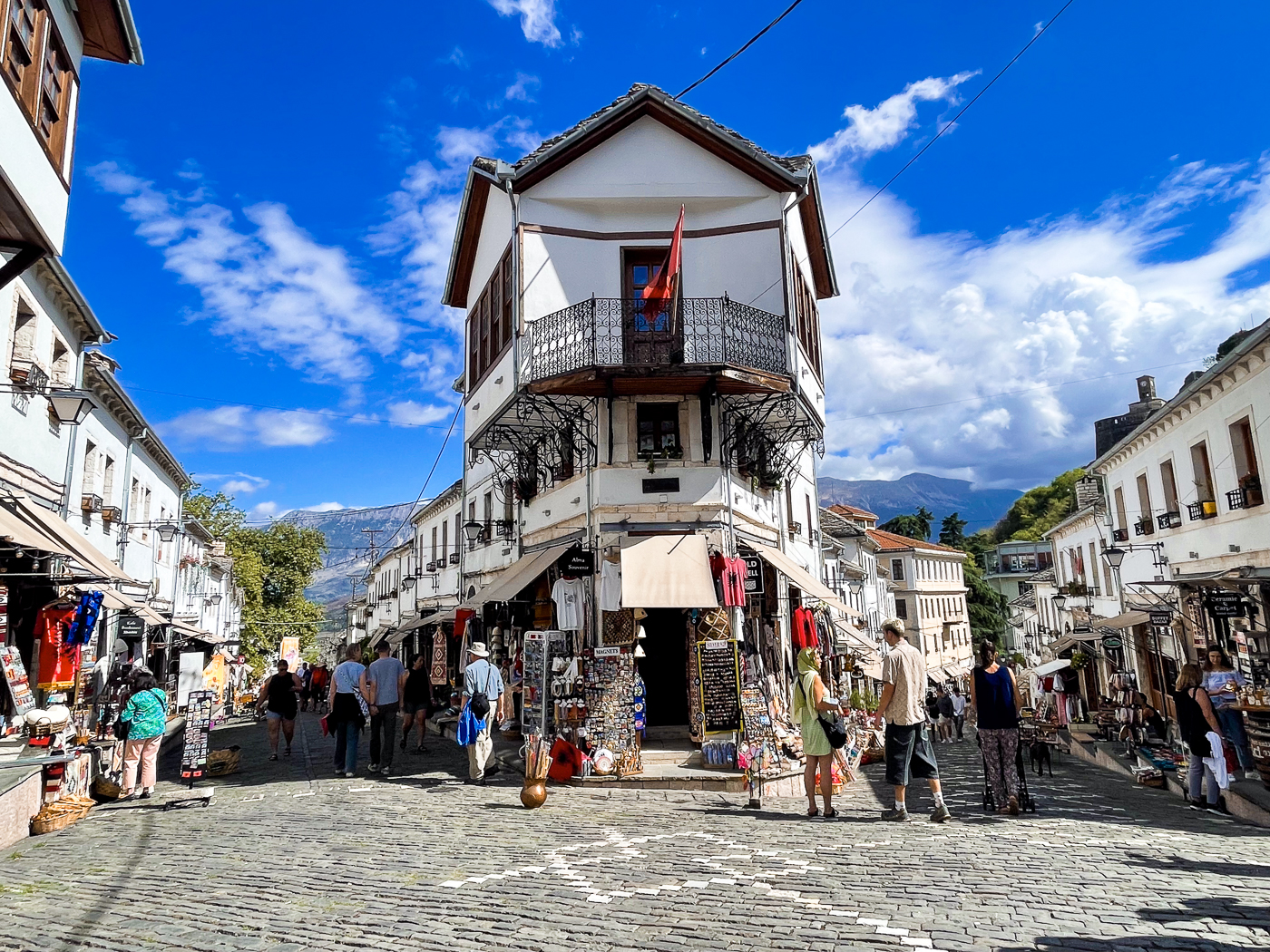
Alsara Guesthouse serves up the most delicious traditional breakfast — I’m still dreaming of their petulla! — so I’d recommend kicking off your day right there on the terrace. Fortunately, the main streets of Gjirokaster stay relatively quiet until later in the morning, so there’s no need to rush.
The heart of Gjirokaster’s bazaar is a popular spot for visitors, but it’s not hard to see why. This town is so picturesque, with its Ottoman-era white-stone houses tumbling down the hillside. It’s here where you’ll take some of your best photos, and if you’re keen to pick up some souvenirs, you’ll find tons of gift shops.
When you’ve finished exploring the bazaar, head up to Gjirokaster’s castle. This 12th-century fortress is a behemoth, perched on the hillside and visible from nearly every part of town. It’s one of the largest castles in the Balkans, in fact, and fun to explore for a couple of hours.
While you’re there, make sure to check out the church and the clock tower. The latter was built by Ottoman leader Ali Pasha. There are two museums inside the complex: the Museum of Gjirokaster and Museum of Armaments. The first is definitely worth checking out; the second less so, unless you’re really into weapons. Since your museum ticket covers both, it’s worth a quick look anyway.
The views overlooking Gjirokaster and the surrounding landscapes are as amazing as you might expect, so plan to spend some time walking around the fortress walls and checking out the town from every angle. Bizarrely, there’s also a U.S. fighter jet in the ground of the castle, after it was impounded by Albanian authorities in the 1950s.
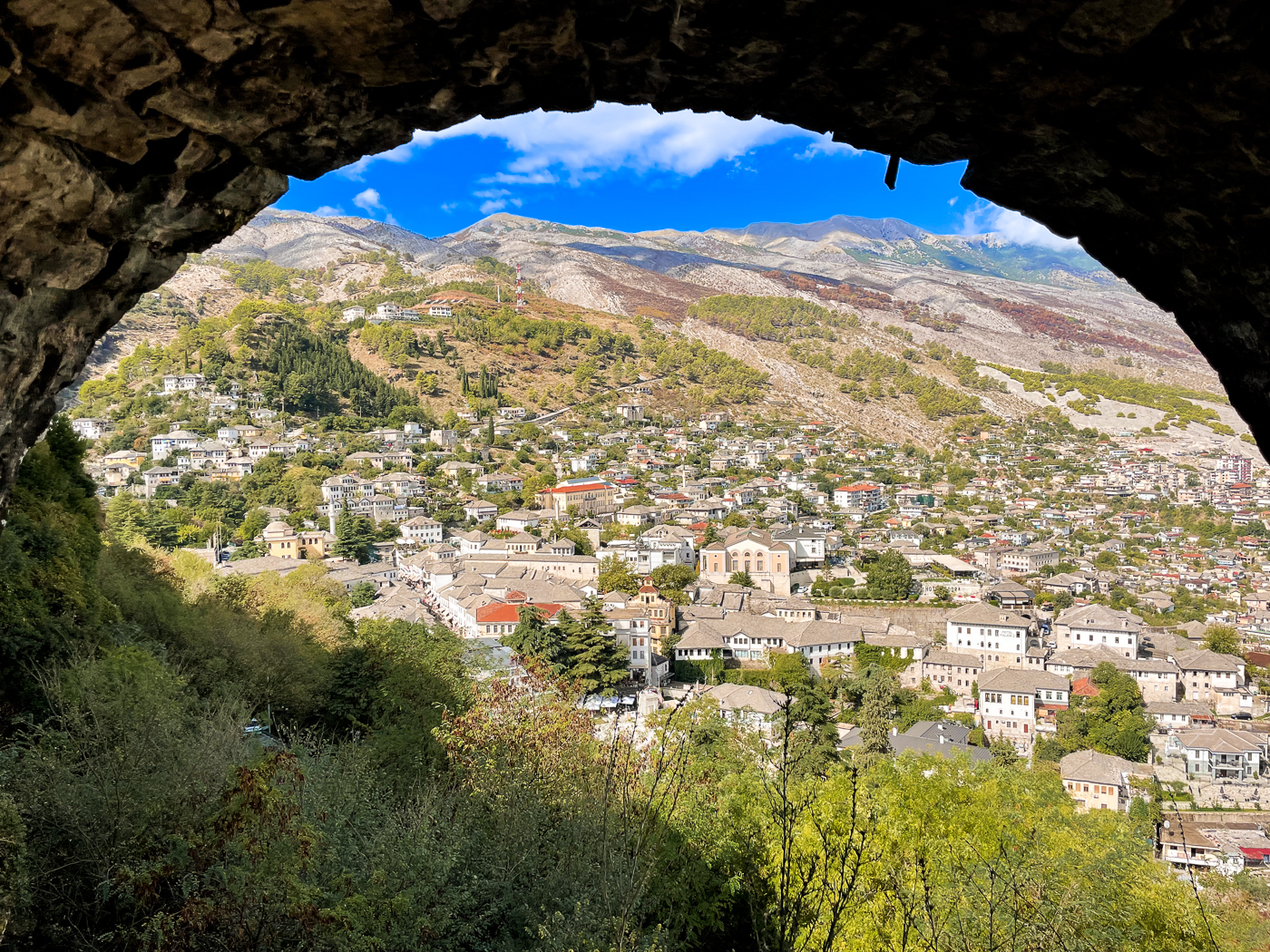
Once you’ve finished up at the castle, it’s time to turn your attention to Ottoman-era Gjirokaster and learn about how the town’s wealthiest families lived. As you’ll soon come to learn, Gjirokaster is full of grand stone houses that have been preserved as museums, each showing how different families lived and loved.
Start with Zekate House, the most famous of them all. It’s huge, with three floors, twin towers, a courtyard, and breathtaking views over the town. Inside, you’ll find traditional furniture, wall paintings, and carved wooden ceilings: all so impressive. There’s also a little cafe on-site with friendly staff and good coffee, so if you’re looking for a break from sightseeing, this is where to do it.
Next up, head to Skenduli House and, if possible, opt to take one of the guided tours around the property — they’re run by descendants of the family who lived there in the 1700s! You’ll learn about the history of the property, what life was like for Albanians in the 18th-century, plus how all the different rooms were used by the owners. It was so much more interesting than it sounds!
There are two other houses you can visit in Gjirokaster — both within a minute’s walk of Skenduli House — but I didn’t think they were as impressive. If you’re short on things to do, consider yourself a completionist, or really like poking around grand homes, you’ll want to take a look at them both. If you’re already feeling housed-out, you can comfortably give them a miss.
Kadare’s House is built on the site of Ismail’s Kadare’s childhood home. This is one of Albania’s most beloved authors, but as my previous sentence hints at: this wasn’t actually his home. The original property burnt down in the 1990s, so this is a reproduction of that, put together to show how his home may have looked. Not quite as exciting! I will say, though, the building itself is beautiful, and if you’re a fan of Kadare’s work, you might feel compelled to visit.
There’s also the Ethnographic Museum, which is located on the site where Enver Hoxha was born. The property focuses more on Albanian culture and its traditions than other houses in Gjirokaster, so there’s lots of exhibits on traditional dress, tools, kitchenware, and furniture. With little-to-no descriptions of what these items are, it’s best to see if you can take a guided tour while you’re there.
Day Six: From Gjirokaster to the Blue Eye and Sarande

Today, we’re heading to the coastline of Albania, and specifically to Sarande. Most visitors to this part of the country choose to stay either there or in Ksamil. For us, it was an easy choice to stay in Sarande.
Ksamil in peak season is heaving with people, pricier than it should be, and once you’ve paid for your sunbed (because all the beaches are privately owned), there’s not much else to do. If you’re after nothing but turquoise water and beach clubs, this may be the spot for you, but Dave and I were looking for something more.
Sarande, on the other hand, makes a much better base. You’ve got restaurants galore, proper supermarkets, bars that stay open late, and a long seafront promenade that’s perfect for an evening wander. And the best part? You can pop into Ksamil whenever you fancy — and we’ll be doing exactly that tomorrow — but still come back to somewhere that feels like an actual town, not just a resort.
Before you get to Sarande, however, I want to tell you about the Blue Eye.
Located roughly half-way between Gjirokaster and Sarande, this natural wonder gets its name from its oval shape and deep blue waters. It’s actually a natural spring, deep underground, formed by water carving its way through soft rock. Today, it gushes up with incredible force into a pool that’s home to some of the clearest water you’ll ever see. Given its location, it makes sense to take a look on the way to the coast.
Once you’ve had breakfast in Gjirokaster, you’ll want to hop aboard the bus to the Blue Eye. From Gjirokaster’s bus terminal, you’ll find buses leaving at 8 a.m., 9 a.m., and 10 a.m. (double-check times with your accommodation owner, as timetables change regularly in Albania) — choose whichever suits you and make sure the driver knows you’ll be getting off at the Blue Eye before you board.
You’ll get dropped off in the car park, and from there, it’s a 25 minute walk to the Blue Eye. You’ll find wooden walkways and viewing platforms at the spring, so you can see it from every angle, plus a few nature trails in the area, too. I’ll confess that the colours aren’t quite as impressive on a cloudy day, but it’s worth visiting nevertheless. Expect to spend two hours there in total; longer if you decide to linger at the restaurant on-site.
Back at the car park, jump on the next bus to Sarande — there’s one at 2:25 p.m. — or there’s KMG Shuttles, which depart at 11 a.m., 12 p.m., and 1:30 p.m.
Sarande is small enough that you can see quite a bit in just one afternoon, and the best way to start is by strolling along the waterfront promenade. Lined with cafes, gelato spots, and benches with views of the Ionian Sea, it’s perfect for people-watching, grabbing an ice cream, and soaking up the sun. I was surprised to see just how close Sarande is to Corfu; I didn’t know that it would be like, right there.
If you’re up for a quick taxi ride or long walk, make the journey up to Lekuresi Castle, which sits on a hill just outside of town. As you might expect, it offers up panoramic views of Sarande and the islands all along the coastline. It’s more commercial than historical — there’s lots of restaurants and cafes up there — but the views are amazing.
Back in town, carve out some time to wander the old town streets. They’re full of charm: colourful buildings, little squares, and, bizarrely, a bronze bust of Hillary Clinton. Stop at one of the seafood restaurants near the port for dinner: fresh fish, calamari, and seafood pasta are all excellent here.
One of the most cherished traditions in Albania is the xhiro — the evening walk. In Sarande, this leisurely stroll along the waterfront promenade is a beloved ritual for locals and a lot of fun to join in on as visitors. As the sun sets over the Ionian Sea, the promenade comes alive with families, couples, and friends, all walking beside the waterfront, chatting, hanging out, and enjoying the cool evening breeze.
Where to stay in Sarande: Memories Apartments (€49 a night)– We loved the bright and beachy-themed apartment we chose for Sarande! We were just steps away from both the ocean and bus station, which made exploring the area particularly convenient. The apartment was large, with a living area, kitchenette, and a lovely balcony that was perfect for drinking wine in the sunshine. Most importantly, the room was on a high level in the building, so we managed to avoid the loud noises that afflict most other properties in town. The only weird part was that the owner refused to text us the lockbox code for the key until we were standing directly in front of the front door!
Day Seven: Butrint and Ksamil Day Trip
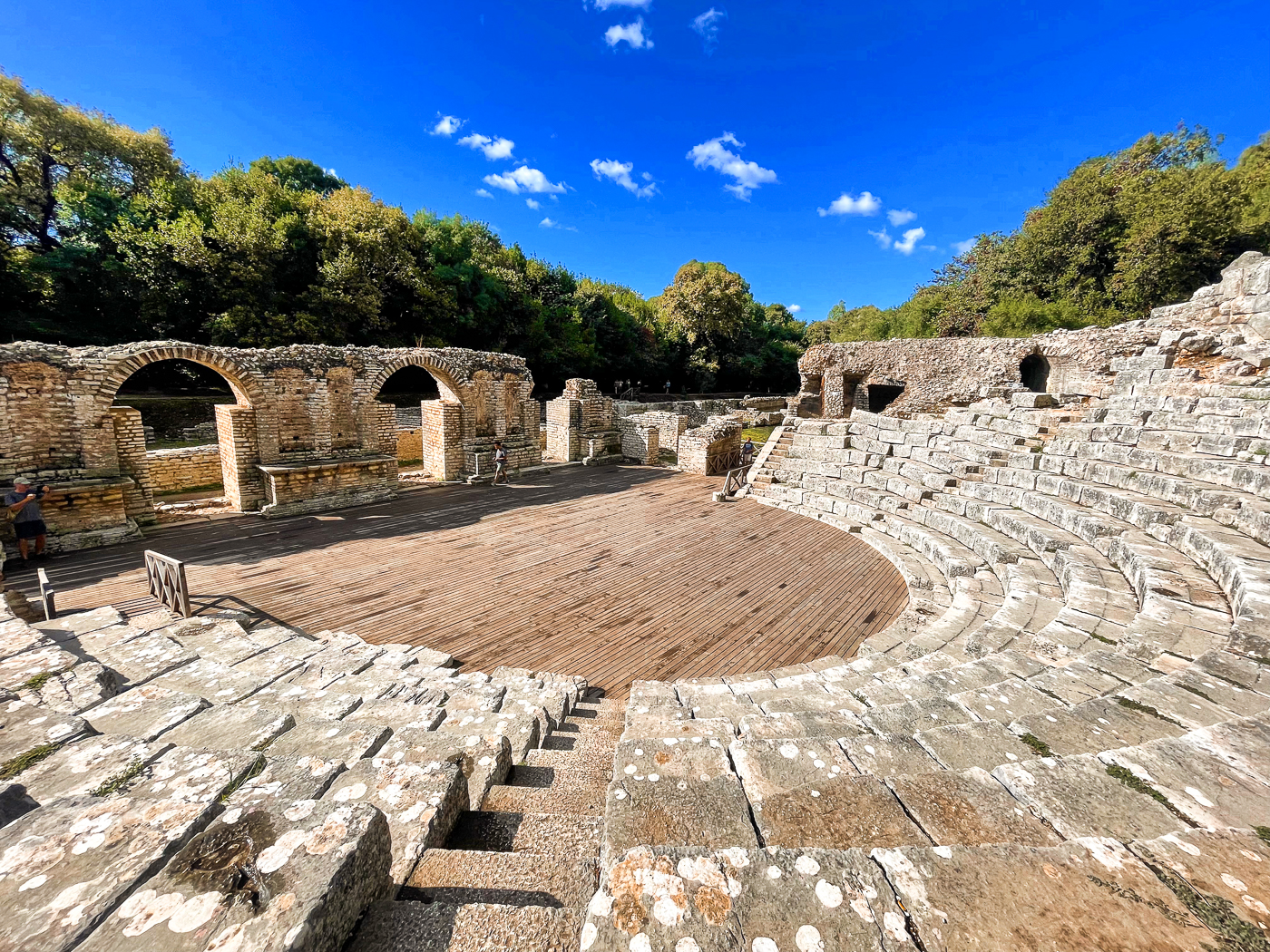
Today’s going to be an action-packed one, as we travel from Sarande to Butrint to Ksamil. The most important move you can make this morning is to get started early. Specifically, I recommend catching the bus at 8:30 a.m. — this got us to the entrance of Butrint at 9 a.m., right when it opened.
At this time of day, you’ll have the entire complex to yourselves, making your explorations so much more enjoyable. As you can see from my photo above, we were at the Ancient Theatre of Butrint with barely anybody else in sight; it’s almost impossible to do so once the tour groups have arrived!
While the theatre is easily the highlight of the complex, Dave and I enjoyed most of the other ruins we saw. Asclepius’s Sanctuary, dedicated to the Greek god of healing, used to attract pilgrims from hither and thither, seeking cures for their various ailments. The Great Basilica, a 6th-century Christian church, is still impressively intact, featuring mosaics and a curved altar, giving a real sense of its former grandeur. And for the best views over the site, the Venetian Castle’s 14th-century watchtower is one that has to be climbed — at the top, you’ll be able to see the whole complex and nearby Vivari Channel.
We spent two hours in Butrint, which I’d estimate is about average for most sightseers. Plan for three hours if you’re a slow walker or really love your ancient ruins.
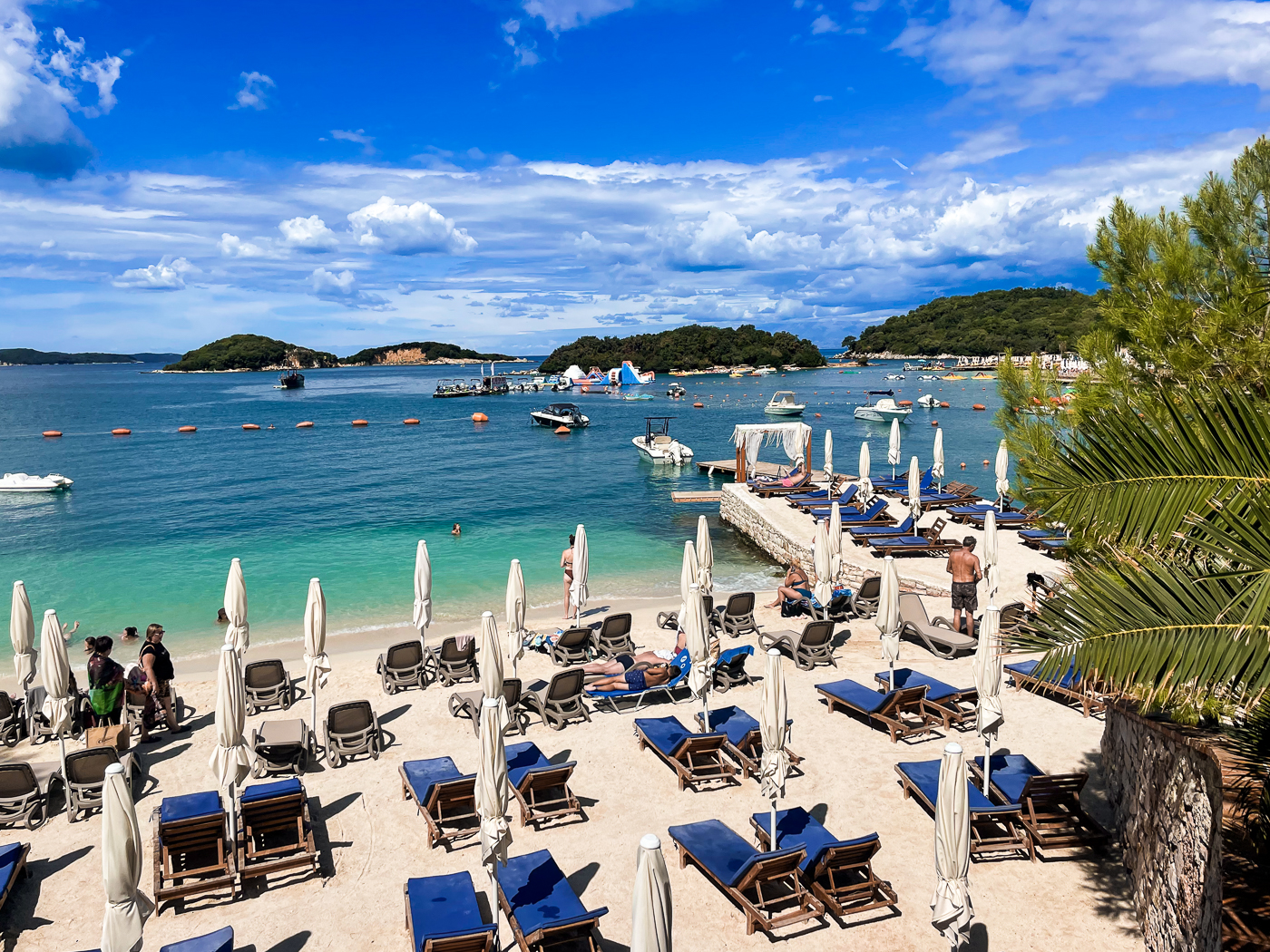
Once you’re suitably ruined-out, it’s time for quite a vibe shift. From Butrint, hop on the next bus to Ksamil: the fanciest spot on the Albanian Riviera.
This may not have been my favourite part of Albania, but it’s popular with tourists and home to one of the best beaches in the country, making it still worth visiting.
The village itself is tiny, but its beaches are stunning: soft sand, crystal-clear water, and a few small islands you can swim or kayak out to if you’re feeling adventurous. In peak season, the beaches get busy and the sunbeds aren’t free — the fanciest ones are €70 a day! — but you can still go for a swim in that beautiful turquoise water.
If you’re not in the mood to swim or sunbathe, there are several activities up for grabs: rent a kayak or paddleboard, wander along the small coastal paths for quieter coves, or grab a drink at one of the seafront cafes or bars and spend a few hours watching the world go by.
Once you’ve had your fill of Ksamil’s sunshine, board the bus to Sarande for a chilled-out evening by the waterfront, plus another round of xhiro, because how could you skip out on something so lovely?
Day Eight: Take the Bus to Himare

My favourite spot in all of Albania? Himare.
After such an action-packed week, this is going to be the part of the trip that’ll feel more like a holiday. The laidback beach town of Himare is significantly less popular with tourists than Sarande or Ksamil, and that’s exactly what makes it so special. You won’t run into jaded locals around here, the prices are reasonable, and the beaches and restaurants are far from crowded. It’s peaceful and calm, but the beaches are still beautiful and — for the most part — sandy.
It takes 90 minutes to travel from Sarande to Himare, and there are buses running between the two every couple of hours. Aim for the 9 a.m. departure if you’re eager to get there, or the 11 a.m. one if you’d prefer a lazier start to the day. Once you arrive in Himare, drop your bags at your guesthouse, grab a towel, and head straight to the water.
The main beach in Himare is actually one of my favourites of the area, as it’s sandy rather than rocky, although it transitions into small pebbles the closer you get to the Ionian. There’s so many great beaches around here, however, that it’s worth taking a stroll to see if there’s one you’d prefer more.
If you walk south from Himare, you’ll first reach Sfageio Beach (mostly sandy, gets the most amount of sun in the afternoon), followed by Maracit Beach (has sun loungers available to rent and a cafe on the sand), then finally Prinos Beach (huge beach, food trucks on the sand, cold water from a nearby underground spring).
One of my favourite photos from my entire Albania trip is the one at the top of the section, and it’s easy for you to get the same shot. The bunker is marked on Google Maps as “small bunker”, located between Maracit and Prinos Beach and requires you to scale a small cliff (not as treacherous as it sounds) to get up to the viewpoint. From there, you’ll be able to snap a photo of the two things that Albania is most famous for: bunkers and beaches!
If you walk north from Himare instead, a 45-minute stroll around the headland leads to Livadhi Beach, one of the area’s longest sandy stretches. It’s quiet and chilled out, and less crowded than some of the more accessible beaches in Himare. It’s worth making the journey if only to take a photo of the beach from the headland: it’s so beautiful from up there!
Our favourite restaurant in Himare was Brothers Grill and Fast Food. Don’t let the name put you off: we had some amazing Greek food in the courtyard here. It was so good, in fact, that we ate here for dinner every single night that we were in Himare. Our go-to was the pork gyro platter that we shared: shredded pork, tomatoes, onions, fries, tzatziki, and pita bread — so good!
Where we stayed in Himare: Sea Breeze Rooms (€55 a night) — Dave and I adored the family that runs this little guesthouse in Himare. It’s set a five-minute walk back from the beach and in a lovely local neighbourhood, with some of the most impressive gardens I’ve seen. The family we stayed with, in particular, are growing so many unusual vegetables that I couldn’t stop taking photos of them! Our room was more basic than anywhere else we stayed, but the family and vibe more than made up for it. In particular, we loved the beachy views from the guesthouse terrace.
Day Nine: Beach Day or Beach-Hopping Day
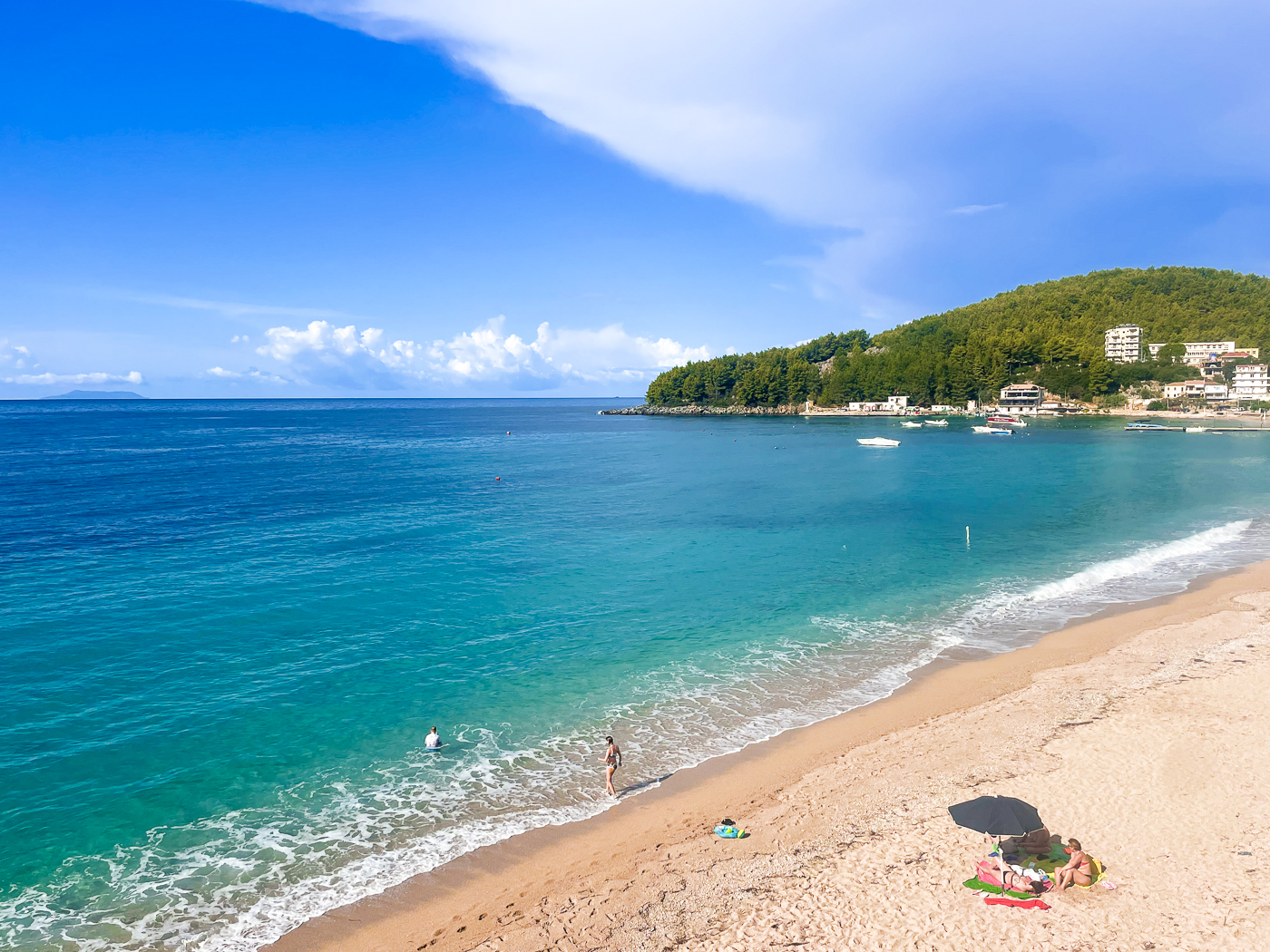
Dave and I had the same breakfast every single day that we were in Himare. What can I say? We loved the offerings at Anemone so much that we couldn’t bear the thought of going somewhere else. Anemone is known for their make-your-own crepes — both savoury and sweet — and they were the perfect way to kick off our day. I always had a breakfast-themed one, with eggs, bacon, tomatoes, onion, mushrooms, and feta. So good!
Depending on when your flight is, this could potentially be your only full day in Himare and you’ve got several options for how to spend it.
The first is the most obvious, and perhaps the most appealing: spending the day on the beach! It’s been a busy trip, so I wouldn’t be surprised if you were keen to switch off, lay your towel on the sand, dip in the clear waters, and let the day slide by. If you didn’t manage to get to all of the beaches on the previous day, today could be a good time to check out a few of them.
If you love your beaches but not your people, I highly recommend jumping on one of the many beach-hopping boat trips that leave from Himare. These tours are amazing, and whisk you along the coastline, taking you to hidden coves and pristine beaches, many of which aren’t accessible by land. The most popular company is Seas the Day, but the guesthouse we were staying in offered an identical trip using their family boat, so we were able to leave our decision-making until the last minute.
Finally, one of the coolest spots in Himare is its old ruined fortress. (Yes, it really does feel like every town in Albania has a castle atop a nearby hill!) It takes roughly 45 minutes to walk up there and from the top, you’ll get some seriously impressive views over the town and coastline.
But it was the fortress itself that I thought was really cool: to be honest, it’s the ruins of a fortress, but that’s what I loved about it. It wasn’t restored and polished like the castles in Berat and Gjirokaster. Instead, it was more of a ghost town, where you could freely wander inside abandoned buildings filled with trees and flowers; nature slowly taking back over.
Despite the ghost town vibe, there are people who live in the fortress, or nearby, and there’s a great cafe up there, too, called Cafe Butterfly. Make sure you don’t miss the local churches (particularly Kisha e Shën Sergjit dhe Bakut and Church of Virgin Mary of Kassiopi), as they’re so atmospheric inside, with faded Byzantine murals painted on crumbling walls.
Day 10: A Relaxing Morning, Followed by a Bus Back to Tirana

Odds are, you’ll be flying out of Tirana, given that it’s the only airport in the country, and if that’s the case, you’ll need to start your journey back to the capital today. There’s two buses that make the most sense to take: the 7 a.m. bus gets you into Tirana at 12:30 p.m., while the 3 p.m. bus gets you in at 6:10 p.m. We took the latter, as we planned to spend a night in Tirana before continuing to North Macedonia.
If you don’t fly out until the following day, or you plan on getting the afternoon bus, look to the previous day for ideas on how to spend your time in Himare. Beach-hopping, fortress-exploring, or lying beside the ocean: all excellent options.
And That Was Albania!
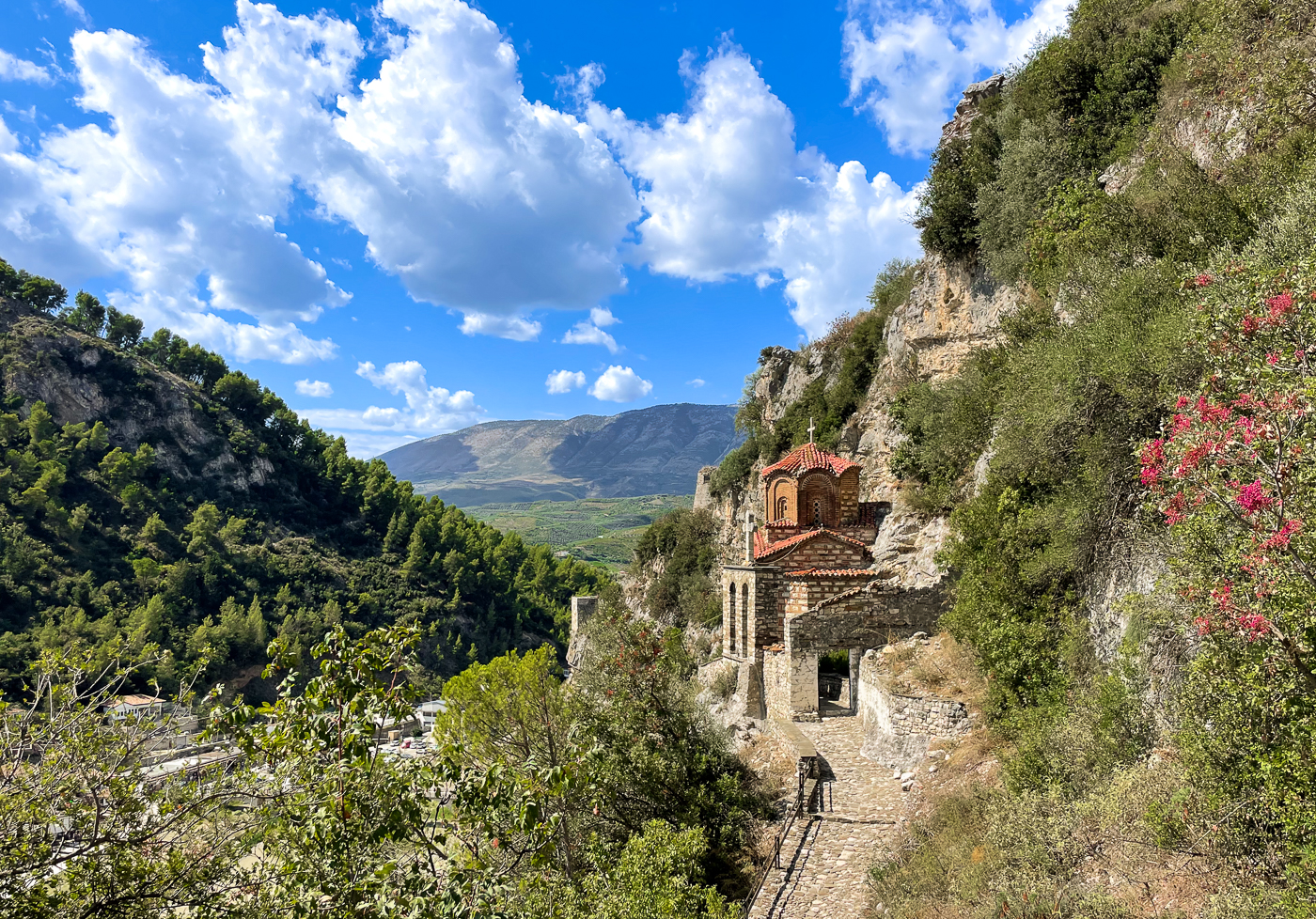
And that’s your 10 days in Albania done and dusted! You’ll have scaled mountains, explored castles, lounged on beaches, and eaten your bodyweight in feta. This isn’t a polished, perfectly-set-up-for-tourism type of country yet, but that’s all part of its frustration charm.
I hope you have an amazing time in this country and then come back to tell me all about it 🙂
Lauren.
The post How to Spend 10 Days in Albania appeared first on Never Ending Footsteps.


